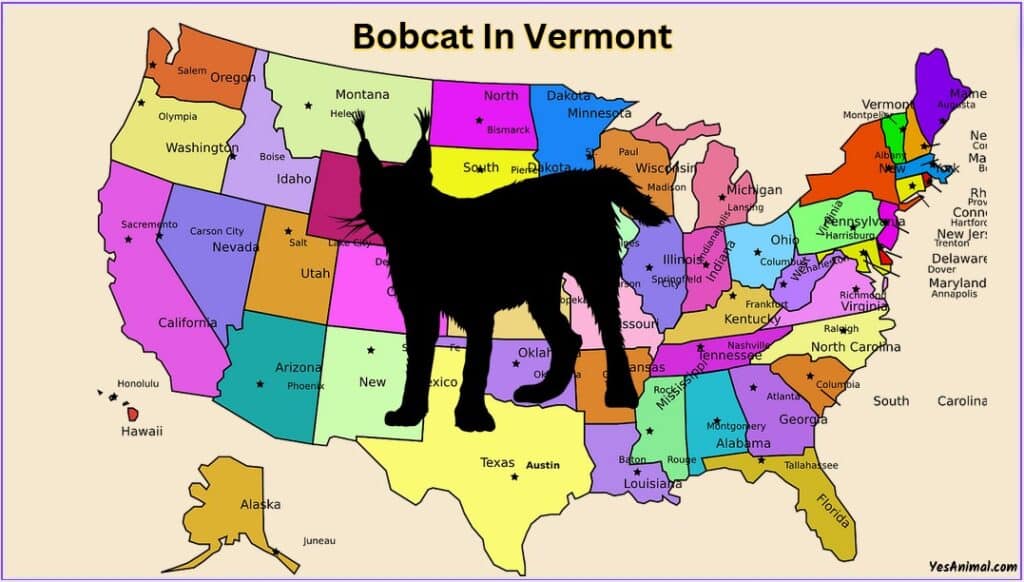Last Updated on September 14, 2023 by Amin Tawar

Vermont is home to many animals that from gigantic moose to small shrews. But, if you are wondering if there are bobcats in Vermont? The quick answer is yes!
Below In this article I’ve explained everything you need to know about the bobcats in Vermont.
Are There Bobcats In Vermont?
Bobcats are found everywhere in the state of Vermont. They live in all kinds of habitats, from rocky mountains to marshy woodlands, and sometimes they even venture into neighborhoods of Vermont too.
After the arrival of European settlement, there was a significant change in the population of mountain lions, wolves, and fishers leaving a predator gap that was filled by bobcats in Vermont. Additionally, prey species were abundant, resulting in the stage for increased bobcats throughout the early 18 century.
After this, there was a bounty law on the bobcat and they were hunted until 1971. Today again bobcats find themselves competing with other animals for pace and food. The return of other animals has made life more challenging in Vermont.
Where Do Bobcats Live In Vermont & How Common Are They?
In Vermont, bobcats are found in a variety of habitats like bogs, coniferous forests, swamps, and partly forested mountain regions. Especially in the northeast, rocky ridges are crucial to their habitat, as denning frequently occurs around them.
The habitat selection might depend on the prey abundance and dense cover for them to hide. For foraging, the perfect habitat is forested swamps to open areas.
Bobcats are highly adaptable, if lucky you can even spot one passing through your yard. But the issues that you might not even notice or know it. This is because they usually tend to avoid moving in broad daytime.
Rather, you can see them before sunrise or after sunset. This is why bobcats are not very commonly to be spotted in Vermont even if they are very high in number.
How Large Is A Vermont Bobcat?

Bobcats are about three times bigger than house cats. They might weigh around 30 pounds. With an average of 18 to 22 pounds. A fully grown adult bobcat can weigh as much as 40 pounds. They can be about 2 to 3 feet long with a short tail being about 7 inches long. Male bobcats are usually a bit bigger than female bobcats.
Their fur is brown to gray, with dark stripes or spots that vary from dark brown to black on their bodies. There are also black stripes on their tails and forelegs.
When you see a bobcat from a side view, you can notice that they are slightly higher at the backside than at the shoulders. Bobcats have long hind legs when compared to their forelegs.
Also Check Our Guide On Bobcats In US
Are Bobcats Aggressive In Vermont?
Bobcats never pose a danger to humans unless they are in danger. They usually avoid humans and which is why they are rarely seen. They might become aggressive when you target them or make them feel cornered.
Female bobcats can turn aggressive when their young ones are in danger. Just like other wild animals bobcats should also be respected and given privacy when encountered in the wild.
What Do Bobcats Eat In Vermont?
Bobcats in Vermont mainly feed on voles, mice, rats, squirrels, chipmunks, snowshoe hares, birds, cottontail rabbits, and deer. The White-tailed deer is an essential food source for the bobcats during winter as snow deepness enables easier predation.
Other than that, as bobcats are opportunists they will take down almost any animal to eat. When prey availability is scarce, they will munch on the remains of dead mammals, also known as carrion.
Can You Kill A Bobcat In Vermont?
In Vermont, you can hunt and trap bobcats during the conservative season which is closely monitored regardless of the bobcat’s population. Annually, more than 100 bobcats are taken down. The bobcat hunting and trapping season is from January to February.
A license is needed, and the trapping and hunting timing are one-half hour after sunset and before sunrise. There are no defined bag limits for hunting bobcats in Vermont.
If a bobcat is damaging your property or is causing disturbance to your livestock, then it is important to inform the department before taking them on your own. As this can be against the law in Vermont.
Can You Own A Bobcat In Vermont?
You cannot own a bobcat in Vermont. It is important to have an importation permit before you import any wild felines into the state. Also, the office will issue permits, if you are looking to have wild felines as pets, private collection, or breeding stock.
There are no issued importation permits for bobcats however, with adequate documentation, they might allow the importation for education, scientific research, or exhibition purposes.
What To Do If You See A Bobcat In Vermont?
If you spot one first then, immediately leave the spot, quietly. Never turn your back, and back away gradually as you make some distance between the cat and you. If the cat sees you, then take an active approach, but that doesn’t mean you will have to approach it. As it can be threatening and escalate an aggressive situation.
Also, make sure never to turn your back as you may look like an easy target. Finally, never run as it can trigger the cat’s predatory instincts, making you look like their prey. This will only make things worst as they are faster than you. Make loud noises using your camping pots, hiking pole, or your voice. You can try spraying some water on the cat.
Also Check Our Guide On Bobcats In Vermont
Conclusion
And that was everything you need to know about the Bobcats In Vermont. I hope this article was informative and your queries were answered.
Thank You For Reading!
Our Goto Source For This Guide